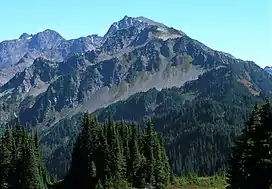Cat Peak
Cat Peak is a 5,940-foot (1,810-metre) mountain summit within Olympic National Park in Clallam County of Washington state.[4]
| Cat Peak | |
|---|---|
 West aspect, seen from High Divide (Mt. Carrie directly behind, and Mt. Fairchild to left) | |
| Highest point | |
| Elevation | 5,940 ft (1,810 m)[1] |
| Prominence | 750 ft (230 m)[2] |
| Parent peak | Mount Carrie (6,995 ft)[3] |
| Isolation | 1.49 mi (2.40 km)[3] |
| Coordinates | 47°54′00″N 123°40′48″W[4] |
| Geography | |
 Cat Peak Location of Cat Peak in Washington  Cat Peak Cat Peak (the United States) | |
| Location | Olympic National Park Clallam County, Washington, US |
| Parent range | Olympic Mountains Bailey Range[5] |
| Topo map | USGS Mount Carrie |
| Geology | |
| Age of rock | Eocene |
| Climbing | |
| First ascent | Unknown[2] |
| Easiest route | class 1 Hiking via High Divide Trail[2] |
Description
Set within the Daniel J. Evans Wilderness, Cat Peak is the westernmost peak of the Bailey Range, which is a subrange of the Olympic Mountains. With clear weather, the mountain can be seen by hikers from High Divide or Hurricane Hill. The nearest higher neighbor is Mount Carrie 1.24 mi (2.00 km) to the east-southeast, and Mount Olympus rises 6.84 mi (11.01 km) to the south.[5] Precipitation runoff from the mountain drains north into Cat Creek which is a tributary of the Elwha River, and south into the Hoh River. Topographic relief is significant as the summit rises over 4,400 feet (1,340 m) above the Hoh River in approximately one mile.
History
The mountain's name has been officially adopted by the U.S. Board on Geographic Names. The peak is named in association with Cat Creek, which heads on the peak. The creek was christened "Wildcat Creek" by the 1889–90 Seattle Press Expedition because an expedition member killed a bobcat on February 28, 1890, where the creek joins the Elwha River.[6]
Climate
Based on the Köppen climate classification, Cat Peak is located in the marine west coast climate zone of western North America.[7] Most weather fronts originate in the Pacific Ocean, and travel east toward the Olympic Mountains. As fronts approach, they are forced upward by the peaks of the Olympic Range, causing them to drop their moisture in the form of rain or snowfall (Orographic lift). As a result, the Olympics experience high precipitation, especially during the winter months. During winter months, weather is usually cloudy, but, due to high pressure systems over the Pacific Ocean that intensify during summer months, there is often little or no cloud cover during the summer. The months June through October offer the most favorable weather for viewing and climbing.[2]
Geology
The Olympic Mountains are composed of obducted clastic wedge material and oceanic crust, primarily Eocene sandstone, turbidite, and basaltic oceanic crust.[8] The mountains were sculpted during the Pleistocene era by erosion and glaciers advancing and retreating multiple times.
Gallery
References
- Olympic Mountain Rescue, Olympic Mountains: A Climbing Guide, 4th Edition, 2006, Mountaineers Books, ISBN 9780898862065, page 191.
- "Cat Peak - Climbers Guide to the Olympic Mountains". climbersguideolympics.com. Retrieved 2022-01-19.
- "Cat Peak - 5,925' WA". listsofjohn.com. Retrieved 2022-01-19.
- "Cat Peak". Geographic Names Information System. United States Geological Survey, United States Department of the Interior. Retrieved 2022-01-19.
- "Cat Peak". Peakbagger.com.
- Parratt, Smitty (1984). Gods and Goblins: A Field Guide to Place Names of Olympic National Park (1st ed.).
- Peel, M. C.; Finlayson, B. L.; McMahon, T. A. (2007). "Updated world map of the Köppen−Geiger climate classification". Hydrol. Earth Syst. Sci. 11: 1633–1644. ISSN 1027-5606.
- Alt, D.D.; Hyndman, D.W. (1984). Roadside Geology of Washington. pp. 249–259. ISBN 0-87842-160-2.
External links
- "Olympic National Park". National Park Service.
- Weather forecast: Cat Peak





.jpeg.webp)